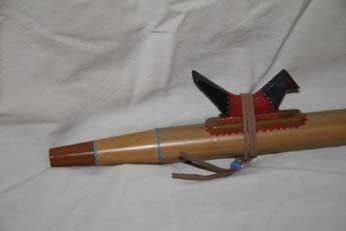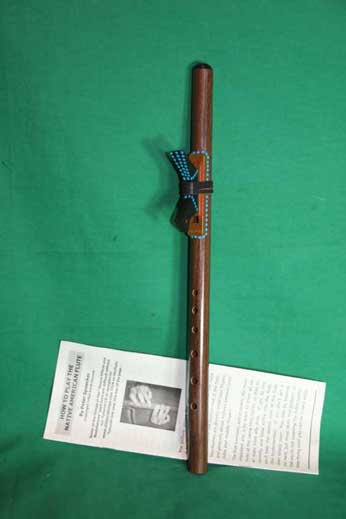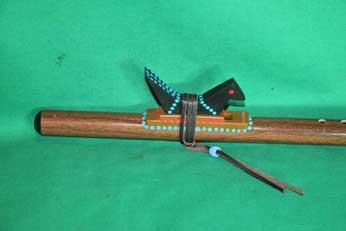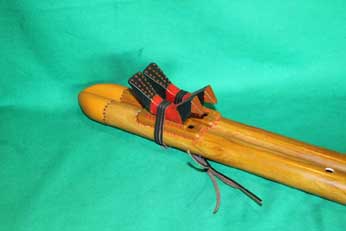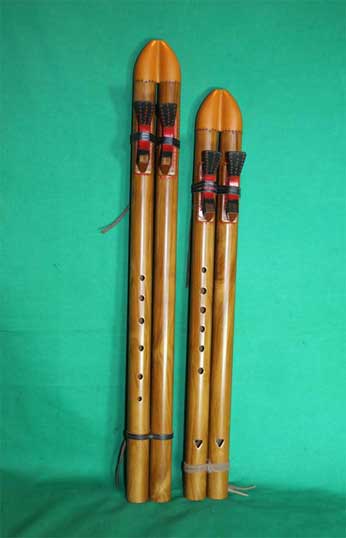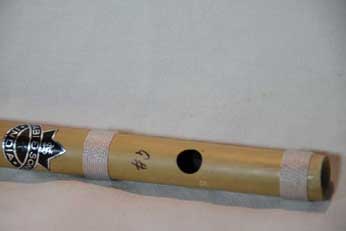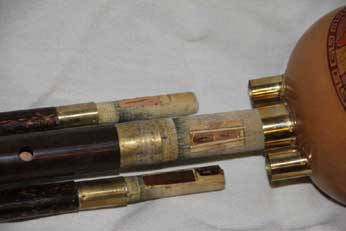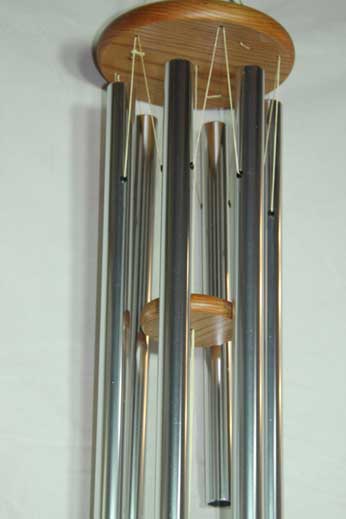Indianerflöte
Indianerflöte - native indian flute, pentatonische Flöte

Die Indianerflöte ist die traditionelle Flöte der nordamerikanischen Indianer, von daher auch native indian flute genannt. Die Tradition dieser Flöte beruht auf einer Legende, das ein Buntspecht einem Indianer gezeigt hat, wie er aus einem Ast eine Flöte bauen kann. Noch heute ist das geschnitzte Vögelchen auf diesen Flöten eine Hommage an den Buntspecht.
Doch dieses Vögelchen ist nicht nur Zierde, sondern hat auch eine Funktion für die Tonerzeugung. Es ist in etwa ein nach aussen gelegter Pflock. Doch nicht nur diese Konstruktion ist aussergewöhnlich, auch die Stimmung der Tonfolge ist traditionell keine Oktave, sondern eine pentatonische Tonfolge. Bei der Pentatonik sind fünf (griech. penta=fünf) Töne aus der Oktave ausgesucht, so das keine Halbtonschritte zwischen den Tönen sind. Halbtonschritte gibt es natürlich in der Tonleiter zwischen den Tönen e und f und den Tönen h und c, ausserdem als Zwischentöne wie ein fis oder ein b.Sucht man nun 5 Töne aus einer Oktave, das keine Halbtonschritte entstehen (bei c-dur wären das z.B. c, d, f, g und a) so baut sich ein sehr harmonisches Klangbild auf, es entstehen keine Dissonanzen zwischen den Tönen. Deshalb kann man in der Pentatonik frei improvisieren und es entsteht immer eine harmonische Melodie. Diese improvisierten, frei harmonisch schwingenden Melodien mit dem weichem, meist tiefem Klang, zeichnen das Klangbild der Indianerflöte aus.
Besonders spannend wird es, wenn die Flöte als Doppelflöte gebaut ist. Dabei werden zwei Flöten zusammengebunden, so das sie gleichzeitig angeblasen werden können. Eine Flöte ist ganz normal mit Fingerlöchern versehen, die zweite Flöte hat keine Fingerlöcher und klingt immer mit dem gleichen Ton, einem so genannten Bordun Ton. Dieser unterlegt entsprechend die Melodie.
Indianderflöte hohe Tonlage
mit 5 Fingerlöchern und einem Daumenloch. Über 2 Oktaven spielbar. sehr intuititv erlernbar, mit einer einfach zu verstehenden Lernanweisung (englisch). Eher eine pentatonische Stimmung, aber mit zusätzlichem Ton.
Der Flöte liegt eine Anleitung und Anregung zum freien improvisierten Spiel bei.
Aus Kunststoff mit Zierkopf
Klangbeispiel hohe Indianerflöte
Indianerflöte tiefe Tonlage
Wie die einfache Indianerflöte aber in tiefer Tonlage (A, G, Fis oder F).
Sehr warmer, weicher Klang. Wie die traditonelle Indianerflöte mit 5 Löchern in pentatonischer Stimmung.
Die Flöte kommt mit einem Baumwollbeutel und Spielanleitung (english).
Aus Kunststoff mit Zierkopf
Klangbeispiel tiefe Indianerflöte
Indianerflöte Doppelflöte
Zwei Flöten, die gleichzeitg über ein Mundstück angeblasen werden. Auf der einen Flöte spielt man eine Melodie, die andere klingt mit einem Grundton, Bordun, mit. Je nach Blasdruck kann dieser variieren, als tiefer Grundton, Quint oder Oktavton. Die Bordun ist auf den tiefsten Ton der Melodieflöte gestimmt.
Die Flöte hat einen tiefen weichen Klang.
Die Flöten gibt es in den Tonarten G, Fis, F und E
Material: Kunststoff
Klangbeispiel doppelte Indianerflöte

 English
English
 French
French
 German
German
